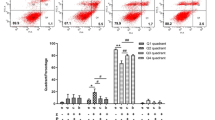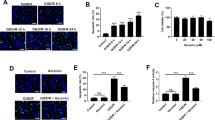Abstract
Asymmetric dimethylarginine (ADMA) is emerging as a key contributor to endothelial dysfunction. The drug probucol was reported to have an anti-lipid peroxidation effect and improve endothelial dilation function. But little is known about the protective effect of probucol on ADMA-induced human brain microvascular endothelial cell (HBMEC) injury and its underlying mechanisms. Therefore, in this study, we investigated the effect of probucol on ADMA-induced HBMEC injury and its potential mechanisms. Results showed that probucol protected against ADMA-induced HBMEC injury in a dose-dependent manner; probucol pretreatment also significantly reduced the level of reactive oxygen species (ROS) and malondialdehyde (MDA), downregulated the expression of pro-apoptotic gene Bax and caspase-3 activity, as well as increased the brain-derived neurotrophic factor (BDNF) release and promoted anti-apoptotic gene Bcl-2 and eNOS expression in the cultured HBMECs. Furthermore, we found that ADMA significantly increased the phosphorylation of c-Jun NH2-terminal kinase (JNK) and p38, while probucol pretreatment effectively inhibited ADMA-induced JNK and p38 phosphorylation in HBMECs. In conclusion, our present results demonstrated that probucol protected against ADMA-induced HBMEC injury and suppressed oxidative stress through the JNK/p38 MAPK pathway, which was the potential underlying mechanism of HBMEC injury in ischemic cerebrovascular disease.




Similar content being viewed by others
References
Bouteldja N, Woodman RJ, Hewitson CL, Domingo E, Barbara JA, Mangoni AA (2013) Methylated arginines and nitric oxide in end-stage renal disease: impact of inflammation, oxidative stress and haemodialysis. Biomarkers 18:357–364
Chen H, Yoshioka H, Kim GS, Jung JE, Okami N, Sakata H, Maier CM, Narasimhan P, Goeders CE, Chan PH (2011) Oxidative stress in ischemic brain damage: mechanisms of cell death and potential molecular targets for neuroprotection. Antioxid Redox Signal 14:1505–1517
Colle D, Hartwig JM, Soares FA, Farina M (2012) Probucol modulates oxidative stress and excitotoxicity in Huntington’s disease models in vitro. Brain Res Bull 87:397–405
Dai X, Chang P, Zhu Q, Liu W, Sun Y, Zhu S, Jiang Z (2013) Chitosan oligosaccharides protect rat primary hippocampal neurons from oligomeric beta-amyloid 1–42-induced neurotoxicity. Neurosci Lett 554:64–69
Ferrari G, Terushkin V, Wolff MJ, Zhang X, Valacca C, Poggio P, Pintucci G, Mignatti P (2012) TGF-β1 induces endothelial cell apoptosis by shifting VEGF activation of p38MAPK from the prosurvival p38β to proapoptotic p38α. Mol Cancer Res 10:605–614
Filomeni G, Piccirillo S, Rotilio G, Ciriolo MR (2012) p38(MAPK) and ERK1/2 dictate cell death/survival response to different pro-oxidant stimuli via p53 and Nrf2 in neuroblastoma cells SH-SY5Y. Biochem Pharmacol 83:1349–1357
Forstermann U, Sessa WC (2012) Nitric oxide synthases: regulation and function. Eur Heart J 33:829–837 837a-837d
Fu H, Li G, Liu C, Li J, Wang X, Cheng L, Liu T (2015) Probucol prevents atrial remodeling by inhibiting oxidative stress and TNF-alpha/NF-kappaB/TGF-beta signal transduction pathway in alloxan-induced diabetic rabbits. J Cardiovasc Electrophysiol 26:211–222
Hardie DG (2011) AMP-activated protein kinase—an energy sensor that regulates all aspects of cell function. Genes Dev 25:1895–1908
Jiang DJ, Jia SJ, Dai Z, Li YJ (2006) Asymmetric dimethylarginine induces apoptosis via p38 MAPK/caspase-3-dependent signaling pathway in endothelial cells. J Mol Cell Cardiol 40:529–539
Kanaji N, Nelson A, Wang X, Sato T, Nakanishi M, Gunji Y, Basma H, Michalski J, Farid M, Rennard SI, et al. (2013) Differential roles of JNK, ERK1/2, and p38 mitogen-activated protein kinases on endothelial cell tissue repair functions in response to tumor necrosis factor-alpha. J Vasc Res 50:145–156
Kolluru GK, Bir SC, Kevil CG (2012) Endothelial dysfunction and diabetes: effects on angiogenesis, vascular remodeling, and wound healing. Int J Vasc Med 2012:918267
Li JF, Chen S, Feng JD, Zhang MY, Liu XX (2014) Probucol via inhibition of NHE1 attenuates LPS-accelerated atherosclerosis and promotes plaque stability in vivo. Exp Mol Pathol 96:250–256
Liao JK (2013) Linking endothelial dysfunction with endothelial cell activation. J Clin Invest 123:540–541
Lv Q, Gu C, Chen C (2014) Venlafaxine protects methylglyoxal-induced apoptosis in the cultured human brain microvascular endothelial cells. Neurosci Lett 569:99–103
Maruyama S, Shibata R, Kikuchi R, Izumiya Y, Rokutanda T, Araki S, Kataoka Y, Ohashi K, Daida H, Kihara S, et al. (2012) Fat-derived factor omentin stimulates endothelial cell function and ischemia-induced revascularization via endothelial nitric oxide synthase-dependent mechanism. J Biolumin Chemilumin 287:408–417
Midwinter RG, Stocker R (2012) Probucol-derivatives in the treatment of atherosclerosis. Atherosclerosis 285
Nishiyama Y, Ueda M, Otsuka T, Katsura K, Abe A, Nagayama H, Katayama Y (2011) Statin treatment decreased serum asymmetric dimethylarginine (ADMA) levels in ischemic stroke patients. J Atheroscler Thromb 18:131–137
Ong JY, Yong PV, Lim YM, Ho AS (2015) 2-Methoxy-1,4-naphthoquinone (MNQ) induces apoptosis of A549 lung adenocarcinoma cells via oxidation-triggered JNK and p38 MAPK signaling pathways. Life Sci. doi:10.1016/j.lfs.2015.03.019
Qin L, Tang B, Deng B, Mohan C, Wu T, Peng A (2015) Extracellular regulated protein kinases play a key role via bone morphogenetic protein 4 in high phosphate-induced endothelial cell apoptosis. Life Sci 131:37–43
Schulz E, Gori T, Munzel T (2011) Oxidative stress and endothelial dysfunction in hypertension. Hypertens Res 34:665–673
Siddiqui WA, Ahad A, Ahsan H (2015) The mystery of BCL2 family: Bcl-2 proteins and apoptosis: an update. Arch Toxicol 89:289–317
Snigdha S, Smith ED, Prieto GA, Cotman CW (2012) Caspase-3 activation as a bifurcation point between plasticity and cell death. Neurosci Bull 28:14–24
Tain YL, Hsu CN, Huang LT, Lau YT (2012) Apocynin attenuates oxidative stress and hypertension in young spontaneously hypertensive rats independent of ADMA/NO pathway. Free Radic Res 46:68–76
Takase B, Nagata M, Hattori H, Tanaka Y, Ishihara M (2014) Combined therapeutic effect of probucol and cilostazol on endothelial function in patients with silent cerebral lacunar infarcts and hypercholesterolemia: a preliminary study. Med Princ Pract 23:59–65
Takechi R, Galloway S, Pallebage-Gamarallage MM, Lam V, Dhaliwal SS, Mamo JC (2013) Probucol prevents blood-brain barrier dysfunction in wild-type mice induced by saturated fat or cholesterol feeding. Clin Exp Pharmacol Physiol 40:45–52
Tormos A, Talens-Visconti R, Nebreda A, Sastre J (2013) p38 MAPK: a dual role in hepatocyte proliferation through reactive oxygen species. Free Radic Res 47:905–916
Verma G, Datta M (2012) The critical role of JNK in the ER-mitochondrial crosstalk during apoptotic cell death. J Cell Physiol 227:1791–1795
Wang Y, Zhang M, Liu Y, Liu Y, Chen M (2011) The effect of nebivolol on asymmetric dimethylarginine system in spontaneously hypertension rats. Vasc Pharmacol 54:36–43
Yoshizuka N, Chen RM, Xu Z, Liao R, Hong L, Hu WY, Yu G, Han J, Chen L, Sun P (2012) A novel function of p38-regulated/activated kinase in endothelial cell migration and tumor angiogenesis. Mol Cell Biol 32:606–618
Author information
Authors and Affiliations
Corresponding author
Rights and permissions
About this article
Cite this article
Ma, J., Zhao, S., Gao, G. et al. Probucol Protects Against Asymmetric Dimethylarginine-Induced Apoptosis in the Cultured Human Brain Microvascular Endothelial Cells. J Mol Neurosci 57, 546–553 (2015). https://doi.org/10.1007/s12031-015-0635-1
Received:
Accepted:
Published:
Issue Date:
DOI: https://doi.org/10.1007/s12031-015-0635-1




